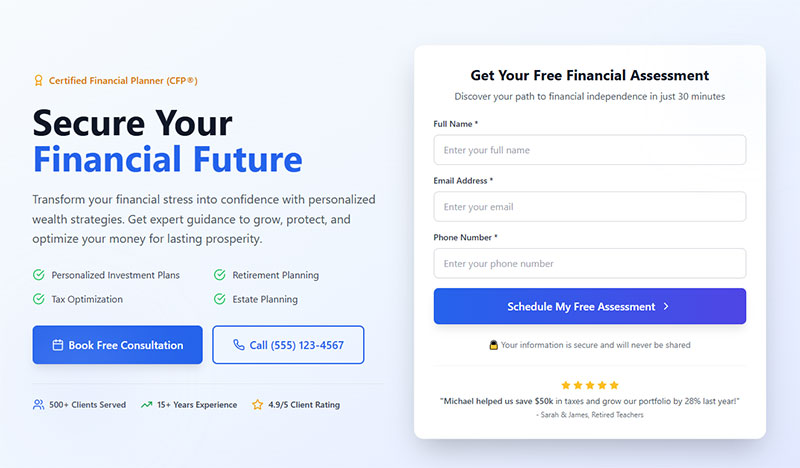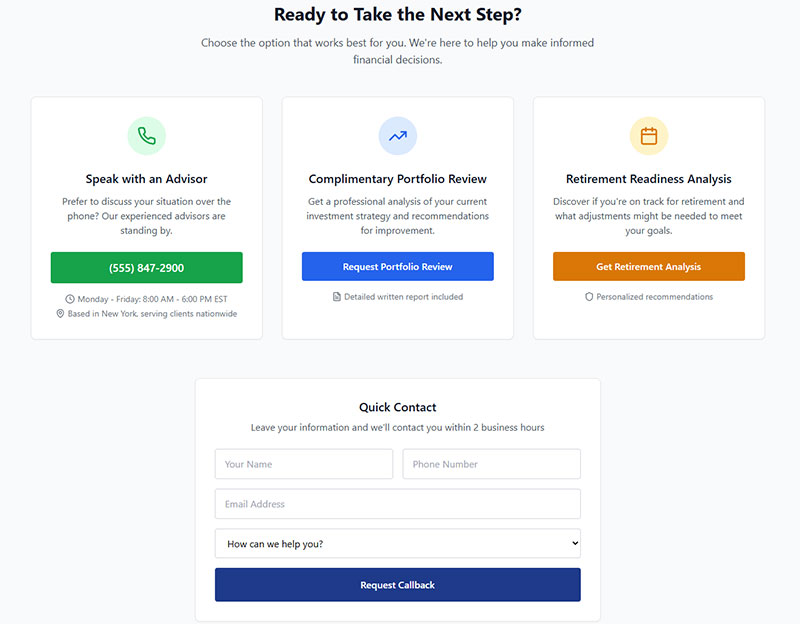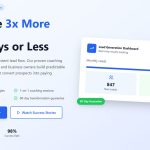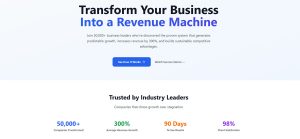Your technical expertise means nothing if nobody knows you exist. Lead generation for accountants has shifted dramatically. Referrals alone no longer fill client pipelines the way they did ten years…
Table of Contents
Most financial advisors struggle with inconsistent client acquisition despite having excellent investment advisory skills. The difference between thriving advisory practices and those barely surviving often comes down to systematic lead generation approaches.
Lead generation for financial advisors requires different strategies than other industries due to regulatory constraints, longer sales cycles, and the high-trust nature of wealth management relationships. Generic marketing tactics rarely work for building a sustainable pipeline of qualified prospects.
This guide reveals proven methods that successful financial consultants use to attract quality clients consistently. You’ll discover content marketing strategies that position you as a trusted authority, social media tactics that generate referrals, and digital advertising approaches that comply with industry regulations.
By implementing these systematic client acquisition strategies, you’ll build predictable revenue growth while serving more clients who truly benefit from your expertise.
Content Marketing Strategies That Generate Quality Leads
Educational Blog Content That Attracts Prospects
Retirement planning content consistently drives highest engagement among potential clients. 47% of buyers engage with 3-5 pieces of content before contacting sales reps. Write detailed guides about 401(k) rollovers, Social Security optimization, and estate planning basics.
Tax strategy articles perform exceptionally well during tax season. 90% of financial service consumers start with online searches. Create content around Roth IRA conversions, tax-loss harvesting, and retirement account withdrawals.
Market commentary builds authority as a financial consultant. 87% of marketers report content marketing generates demand and leads (up 11% since 2023). Weekly market updates establish thought leadership while demonstrating portfolio management expertise.
Content Performance Statistics:
- Content marketing generates 3x more leads than traditional marketing
- Average cost per lead: $92 for content marketing
- 74% of marketers say content marketing builds loyalty
- Professional services achieve 4.6% conversion rates (highest of all industries)
Video Content for Financial Education
Video content generates 3x more engagement than text-based posts. 89% of video marketers say videos help with lead generation. Weekly market updates create consistent touchpoints with prospects.
Client success story presentations showcase real results. 25% of marketers agree video content offers highest ROI. Share how you helped clients navigate market volatility or achieve retirement goals.
FAQ videos address common concerns about fiduciary responsibilities and fee structures. 44% of consumers prefer learning about products/services through video content.
Video Marketing Impact:
- 91% of shoppers want more brand videos online
- 53% of marketers say webinar landing pages generate highest-quality leads
- Videos appear on 10% of search engine results pages
- Short-form video ranks most effective for 43% of content marketers
Lead Magnets That Convert Visitors
Financial planning checklists work exceptionally well for lead capture forms. Multi-step forms can increase conversions by 300%. Create downloadable retirement readiness assessments or investment portfolio reviews.
Tax optimization guides tailored to specific demographics generate qualified leads. Personalized experiences are 215% more likely to generate new leads successfully.
Retirement calculators integrated with websites capture prospect information while providing valuable tools. Interactive content enables leads to actively engage with your services.
Lead Magnet Performance:
- Financial services CPL: $653 (second highest industry)
- Average organization generates 1,877 monthly leads
- 81% qualify as marketing-qualified leads
- 96% of marketers say personalization leads to repeat business
Email Marketing Sequences for Nurturing Leads
Welcome series should deliver immediate value. Email marketing is most effective lead generation channel for 48% of marketers. Send 5-part sequences covering portfolio diversification and risk management.
Educational drip campaigns work best when segmented by client type. Segmented campaigns drive 30% more opens and 50% higher click rates than non-targeted batches.
Market update newsletters with strategic calls-to-action keep your practice top-of-mind. Average email CTR across industries: 1.86% in 2024.
Email Performance Benchmarks:
- $36 return for every $1 spent on email marketing
- 47% of recipients open emails based solely on subject lines
- Mobile optimization is crucial: 62% access websites via mobile
- Retail/ecommerce achieves 45:1 ROI with email marketing
Social Media Lead Generation Tactics
LinkedIn Strategies for Professional Networking
LinkedIn remains the most effective social platform for financial advisor marketing. LinkedIn drives 80% of all B2B leads from social media, with 36 million financial services professionals actively using the platform.
Optimize your profile with keywords like “retirement specialist” and “investment counselor.” LinkedIn’s visitor-to-lead conversion rate is 2.74%, nearly 3x higher than Facebook or Twitter.
Share valuable content consistently rather than selling directly. Thought leadership posts get 3x more shares. Post insights about market trends, regulatory changes, or financial planning strategies.
Direct outreach works thoughtfully. LinkedIn lead generation is 227% more efficient than other networks. Connect with business owners and executives matching your ideal client profile.
LinkedIn Performance Metrics:
- 40% of B2B marketers rate LinkedIn as most effective for high-quality leads
- 89% of B2B marketers use LinkedIn for lead generation
- Cost per lead 28% lower than Google AdWords
- Company pages generate 10% of leads despite only 0.59% of content
Facebook Marketing for Local Client Acquisition
Local business groups provide direct access to potential clients. Facebook’s average cost per lead is $21.98 across industries, ranging from $13.87 for real estate to $104 for legal services.
Facebook ads allow precise demographic targeting for wealth advisor services. Target users by age, income level, job titles, and interests related to investing.
Live streaming builds real-time engagement. Host monthly sessions covering market updates, tax planning, or retirement income planning for immediate prospect interaction.
Facebook Lead Generation Stats:
- 51% of marketers select Facebook as top choice for B2C marketing
- 33% choose Facebook as second choice for B2B lead generation
- 90% of B2B marketers reduced cost per lead using Facebook Lead Gen forms
- Average engagement rates significantly lower than LinkedIn for financial services
YouTube Channel Development for Long-term Growth
Educational content creates evergreen lead generation opportunities. YouTube has 2.5 billion monthly active users with 238 million in the US.
Optimize videos for search discovery using relevant keywords. 89% of video marketers say videos help with lead generation. Title videos with phrases like “401k rollover process” that prospects search for.
Build subscriber engagement through consistent posting. 59% of marketers plan to increase YouTube usage over the next 12 months.
YouTube Performance Data:
- 51% of marketers currently use YouTube for marketing
- 25% of marketers agree video content offers highest ROI
- Videos appear on 10% of search engine results pages
- Short-form video ranks most effective for 43% of content marketers
Performance Tracking and Optimization
Consistent content creation requires systematic planning. Develop calendars aligning with tax seasons, market events, and client needs.
Track performance metrics for each platform. 75-90% of financial services searches start online, making digital presence crucial.
Monitor which topics generate engagement, shares, and actual client inquiries. LinkedIn generates 277% more leads compared to Facebook and Twitter combined.
Key Success Metrics:
- LinkedIn engagement rate has risen 12% year-over-year
- Carousels and PDFs generate 1.9x more engagement than standard posts
- 800-1000 word posts receive 26% more engagement
- Financial services has second-highest cost per lead at $653
Referral Programs and Partnership Development
Systematic Client Referral Programs
Client acquisition through referrals remains cost-effective despite declining dominance. 53% of new advisor clients come from referrals, but this is shifting as digital marketing gains importance.
Referral conversion statistics show significant advantages: Client referrals take 1.7 months to convert versus 3.6 months for marketing leads. However, only 29% of financial advice buyers require referrals to choose advisors.
Create compliance-friendly incentives like account credits, charitable donations, or gift cards within regulatory limits. Check with compliance teams before implementation.
Training clients on quality referrals improves success rates. Explain which prospects benefit most from your services and share specific impact scenarios.
Demographic shift challenges:
- 60% of clients over 60 require referrals to hire advisors
- Only 17% under 44 require referrals; 57% select based on digital marketing
- 45% of near-retirement clients hired through digital channels
Following Up on Referral Opportunities
Contact referred leads within 24 hours while conversations remain fresh. Response time significantly impacts conversion rates.
Relationship development starts by acknowledging mutual connections. Reference referring clients and explain how you’ve helped with similar challenges.
Track referral sources to identify valuable client advocates. Focus relationship management on consistent referral providers.
Performance metrics:
- 67% of new clients and assets come from referrals and COI relationships
- RIAs with documented marketing plans attract 67% more new clients
- Referrals account for 1.8% AUM growth vs 6.4% from other strategies
Professional Referral Networks
CPAs and estate planning attorneys represent ideal partners. These professionals encounter clients needing comprehensive wealth management regularly.
Create documented mutual agreements benefiting both practices. Refer tax planning and legal needs while receiving investment referrals.
Building CPA Relationships
Tax professionals see client situations during preparation, identifying retirement optimization and estate planning opportunities.
Meet regularly to discuss mutual clients and referral potential. Share tax-efficient strategies while learning about planning needs.
Attorney Partnerships
Estate planning attorneys work with clients needing ongoing trust and estate investment management—often high-value, long-term relationships.
Attend bar association events and estate seminars. Build relationships with attorneys serving your target demographic.
Community Partnerships for Local Lead Generation
Chamber membership connects you with business owners needing personal and business financial planning.
Speaking at community organizations positions you as the local financial consultant. Present retirement readiness, college funding, or business retirement topics.
Community engagement through event sponsorships increases visibility among target prospects at charity events, tournaments, and educational seminars.
Strategic considerations:
- Average advisor spends $15,900 annually on marketing
- Defined marketing strategies result in 50% more client onboarding
- Digital marketing importance growing while referrals remain valuable but insufficient alone
Digital Advertising and Paid Lead Generation
Key Insights:
- LinkedIn offers the best value for financial advisor B2B targeting
- Google Ads provide highest intent but at premium pricing
- Facebook costs significantly more per click for financial services
Google Ads for Financial Advisory Services
Google Ads campaigns require careful keyword selection for financial planning terms. Target phrases like “retirement planning advisor,” “fiduciary financial advisor,” or “wealth management services” in your local market.
Financial Services Costs:
- Finance & Insurance CPC: Averages $6.40-$8.94
- Average cost per lead: $70.11 (up 5.13% from 2024)
- Conversion rate: 2.78% (among lowest industries)
- Cost per lead increased 62.73% month-over-month in financial services
Compliance considerations affect ad copy significantly. Avoid performance claims, guarantee language, or testimonials that violate regulations. Focus on education, credentials, and service descriptions.
Landing page optimization directly impacts conversion rates. Create dedicated pages for each campaign matching search intent and providing clear next steps.
Keyword Research Strategy
Long-tail keywords provide better ROI than broad terms. “Fee-only financial advisor near me” converts better than generic “financial advisor” searches due to specific intent.
Local keywords work exceptionally well. Include city names and regional terms that prospects use when searching for nearby investment advisors.
Negative keywords prevent wasted spend. Exclude “jobs,” “free,” “DIY,” or “software” that attract job seekers rather than advisory clients.
Keyword Performance:
- Business Services CPL: $87+ (highest category)
- Local search budget: $980-$1,470 monthly for 10 leads (financial planners)
- Start with 20+ leads weekly for effective campaigns
- Geographic targeting significantly impacts costs
Facebook and LinkedIn Paid Advertising
LinkedIn advertising allows precise targeting by job title, company size, and industry. Target executives, business owners, and professionals matching your ideal client profile.
Facebook’s demographic targeting reaches prospects by age, income level, and life events. Target users approaching retirement, experiencing job changes, or showing investment interest.
Social Media Advertising Costs:
- LinkedIn CPL: 28% lower than Google AdWords
- Facebook average CPL: $21.98 across industries
- LinkedIn conversion rate: 2.74% (3x higher than Facebook)
- Financial services: $13.87-$104 CPL range on Facebook
Retargeting Website Visitors
Retargeting campaigns re-engage visitors who viewed your website but didn’t contact you initially. These prospects already showed interest in financial planning services.
Create different messages for visitors who viewed specific service pages. Someone reading about retirement planning needs different messaging than estate planning prospects.
Lead form ads capture information directly within social platforms, reducing friction while maintaining compliance.
Managing Advertising Budgets and ROI
Set realistic cost-per-lead expectations based on average client value. Financial advisory leads cost more due to high lifetime value.
Budget Guidelines:
- SMB starting budget: $1,000-$2,500 monthly
- New campaigns: $20-50 daily
- Most businesses spend: $1,000-$10,000 monthly
- Average daily budget calculation: Monthly budget ÷ 30.4
Test different ad variations systematically. Try different headlines, images, and calls-to-action while keeping other variables constant.
Track leads through to actual client conversion rather than stopping at initial contact. Many prospects require multiple touchpoints before becoming clients.
Budget Allocation Strategy
Start with smaller budgets to test performance before scaling. Allocate 70% to proven campaigns, 30% to testing new strategies.
Marketing automation tools help track lead sources and conversion paths. Connect advertising platforms with CRM systems to see which campaigns generate actual clients.
Key Performance Metrics:
- Quality Score improvement lowers CPC and improves positioning
- Industry conversion rates declining 14% average across sectors
- Cost per lead rising but at slower pace than previous years
- Financial services saw only 2% decrease in CPL (better than most industries)
Website Optimization for Lead Conversion
Landing Page Design That Converts Visitors

Value propositions must speak directly to specific client types. Business owners need different messaging than pre-retirees or young professionals starting their investment journey.
Financial Services Conversion Benchmarks:
- Average conversion rate: 2-5% (varies by service type)
- Top 10% performers: 8.3-24% conversion rates
- Insurance leads industry: 18.2% (highest in financial services)
- Investment/wealth management: 3.9% average
Clear headlines address immediate pain points. “Worried about retirement readiness?” resonates better than generic “Financial planning services.” Be specific about problems your wealth management approach solves.
Trust signals build credibility instantly. Display certifications, client testimonials (with permission), and professional credentials prominently. Financial sector requires high trust levels due to sensitivity around money decisions.
Essential Trust Elements
Professional headshots create personal connections before meetings. Include brief bios highlighting relevant experience in portfolio management or retirement planning specialties.
Client testimonials demonstrate real results. At least 50 reviews signals social proof and reliability. Share specific outcomes like “helped save $50,000 in taxes through Roth conversions” rather than generic praise.
Regulatory disclosures and privacy policies show professionalism, reassuring prospects about fiduciary responsibilities and data protection.
Call-to-Action Strategies Throughout Your Site

Strategic contact forms placement increases conversion opportunities. Include simple forms on service pages, blog posts, and resource downloads rather than only contact pages.
Free consultation offers outperform generic “contact us” buttons. Specific offers like “complimentary retirement analysis” or “portfolio review” provide clear value propositions.
Phone numbers should appear prominently on every page. Many prospects prefer calling for sensitive financial discussions.
Optimizing Form Fields
Shorter forms generally convert better. Ask for name, phone, email, and one qualifying question about assets or retirement timeline.
Multi-step forms can improve completion rates by breaking information gathering into digestible sections. Only one-third of people start entering form data, showing value in A/B testing.
Conditional logic shows relevant questions based on previous answers, making forms feel more conversational and less intimidating.
SEO Strategies for Financial Advisory Websites
Local SEO targets prospects in your service area. Optimize for searches like “financial advisor near me” or “retirement planning [your city].”
Content optimization around financial planning keywords drives organic traffic from prospects actively seeking advisory services.
Quality backlinks from reputable financial websites improve search rankings. Guest posting on industry publications builds domain authority.
Local Search Optimization
Google My Business profiles must include accurate NAV information. Add photos, service descriptions, and regular posts about financial planning topics.
Local directory listings in Chamber of Commerce sites and professional organizations improve visibility. Ensure consistent business information across platforms.
Client reviews on Google boost local search rankings. Financial advisors average 0.75% conversion rate from website visitors to booked meetings, making optimization crucial for growth.
Lead Qualification and Follow-Up Systems
Scoring and Prioritizing Incoming Leads
Lead scoring systems help identify prospects most likely to become clients. Advisors should aim for a conversion rate of 10% to 20%, meaning you need to generate between 100 and 150 leads annually to add 10-15 new clients.
High-priority scoring factors:
- Portfolio review requests
- Immediate financial planning needs
- Recent life events (job changes, inheritance)
- Minimum asset thresholds met
- Active engagement with content
Hot prospects require immediate attention while information seekers need nurturing campaigns. The average firm converts 37% of their qualified leads (prospects) to clients, while the conversion rate for leads is 21%.
Qualification criteria should align with your ideal client profile. High-net-worth prospects may score higher, but don’t ignore younger professionals with growing incomes and long-term potential.
Asset-Based Qualification
Minimum asset thresholds help focus efforts on prospects who meet your service model. Fee-only advisors typically need higher minimums than commission-based practices.
Current financial situation indicators include employment status, retirement timeline, and immediate financial challenges. Recent life events like job changes or inheritance often trigger advisory needs.
Investment experience levels affect service requirements and fee structures. First-time investors need more education while experienced clients may want specialized strategies.
Effective Follow-Up Sequences and Timing
If a business responds within an hour, leads are 7 times more likely to convert compared to those who wait longer. Contact new leads within 24 hours while their interest remains high and before competitors respond.
Response time statistics:
- 1 minute: 391% improvement in conversions
- 5 minutes: 10x more likely to reach prospects
- 30 minutes: 21x less effective than immediate response
- 1 hour: 7x more likely to convert vs longer delays
Nurturing sequences for warm prospects should provide ongoing value through educational content. Share market insights, planning tips, and invitations to educational events.
Client referrals take an average of nearly two months (1.7) to convert to clients, while leads from other marketing initiatives take an average of nearly four months (3.6) to convert.
Re-engagement campaigns revive interest from prospects who went cold. Send quarterly check-ins with new resources or market updates that might spark renewed interest.
Systematic Follow-Up Protocols
Week 1 follow-up includes initial phone call, email with relevant resources, and scheduling attempt for consultation. The first vendors to respond to leads win 35-50% of sales.
Essential follow-up touchpoints:
- Day 1: Initial phone call within 24 hours
- Day 2: Email with relevant resources
- Day 3: Text message or LinkedIn connection
- Day 7: Second phone attempt with new value proposition
- Weekly: Educational content via email
- Monthly: Market updates and check-ins
Monthly nurturing emails keep your advisory practice top-of-mind without being pushy. Share market commentary, planning tips, or invitations to educational webinars.
CRM automation ensures consistent follow-up even during busy periods. 75% of financial advisors using CRM systems experienced an increase in client satisfaction.
Set up workflows that trigger based on lead source, qualification score, or response behavior.
CRM Systems for Lead Management
Choose CRM platforms designed for financial advisors that include compliance features. Systems like Redtail, Wealthbox, or Salesforce Financial Services offer industry-specific functionality.
Top CRM features for advisors:
- Compliance tracking and documentation
- Automated lead scoring and alerts
- Integration with marketing tools
- Pipeline visualization
- Activity logging and reporting
- Email and text automation
Automated workflows handle routine follow-up tasks while flagging leads requiring personal attention. Set up alerts for high-priority prospects or time-sensitive opportunities.
Only 38% of firms formally track leads, despite most advisors having CRM systems. This represents a massive missed opportunity.
Integration with marketing tools creates seamless lead nurturing processes. Connect email marketing platforms, webinar registration forms, and social media management tools.
Lead Source Tracking
Attribution tracking identifies which marketing channels generate the best clients. Track leads from initial source through to client conversion and lifetime value.
Advisors with a defined marketing plan generated 168% more leads per month from their website compared to those without a defined marketing plan.
Conversion rate analysis by source helps optimize marketing budget allocation. Financial services comes in second at $653 per lead for cost per lead across industries.
Focus spending on channels that generate qualified prospects rather than just high lead volume.
ROI measurement includes both acquisition costs and client lifetime value. Calculate true cost per client rather than just cost per lead to understand marketing effectiveness.
Pipeline Management Tools
| Tool | Primary Use Case | Key Differentiator | Target User |
|---|---|---|---|
| Pipedrive | Visual sales pipeline management with deal tracking | Intuitive drag-drop interface with activity-based selling | Small-medium sales teams |
| HubSpot Sales Hub | Integrated sales pipeline with marketing automation | Free tier with comprehensive inbound methodology | Growing businesses seeking unified growth platform |
| Salesforce Sales Cloud | Enterprise-grade sales force automation | Advanced customization with AppExchange ecosystem | Large enterprises with complex sales processes |
| Monday CRM | Visual project management with CRM capabilities | Colorful, collaborative interface with workflow automation | Teams needing combined project management and CRM |
| Insightly | CRM with built-in project management features | Relationship-focused CRM linking contacts to projects | Service-based businesses managing client relationships |
| Salesmate | Smart CRM with built-in communication tools | Integrated phone, email, and text messaging platform | Sales teams prioritizing communication efficiency |
| Apache Airflow | Workflow orchestration for data engineering pipelines | Python-based DAG definition with extensive operator library | Data engineers building complex ETL workflows |
| Apache NiFi | Real-time data flow management and processing | Visual flow designer with data provenance tracking | Enterprise teams managing sensitive data flows |
| SnapLogic | Cloud-native integration platform as a service (iPaaS) | Pre-built connectors with AI-powered data integration | Enterprises seeking low-code integration solutions |
Sales Pipeline Management (CRM) in blue | Data Pipeline Management (ETL/Integration) in green
Visual pipeline stages help track prospect progression from initial contact to client onboarding. Typical stages include inquiry, qualification, consultation, proposal, and conversion.
Prospect conversion rates may range from as low as 5% to as high as 75% depending on the advisor’s process and target market.
Activity tracking ensures consistent communication with prospects throughout the sales process. Log calls, emails, meetings, and follow-up tasks for complete prospect histories.
Reporting dashboards provide insights into conversion rates, pipeline velocity, and lead source performance. Use this data to continuously improve your lead generation and conversion processes.
40% of advisors have added new clients through social media, with LinkedIn and Facebook showing the highest conversion rates.
Measuring and Improving Lead Generation Performance
Key Metrics Every Financial Advisor Should Track
Lead conversion rates vary significantly by source and require individual tracking. Referrals typically convert at 40-60% while digital advertising averages 2-5% for financial advisory services.
Conversion rate benchmarks by source:
- Referrals: 40-60% (highest converting source)
- Content marketing: 15-25% with longer nurturing
- Social media: 5-15% depending on platform
- Purchased leads: Below 10% conversion rate
- Digital advertising: 2-5% average for financial services
Cost per lead alone doesn’t tell the complete story. A $500 LinkedIn lead that becomes a $2 million AUM client provides better ROI than ten $50 Facebook leads that never convert.
Financial services comes in second at $653 per lead across industries. The average cost for a financial services lead has stabilized at this level throughout 2024.
Lifetime value calculations should guide marketing budget decisions. High-net-worth clients often justify higher acquisition costs due to their long-term relationship value and referral potential.
Conversion Rate Benchmarks
Referral leads convert highest among all sources. Personal recommendations carry built-in trust that reduces the typical sales cycle length for wealth management services.
Content marketing leads require longer nurturing periods but often become ideal clients. Educational content attracts prospects who value expertise and prefer fee-only advisory relationships.
Social media leads need careful qualification since platforms attract various engagement levels. LinkedIn generates more qualified prospects than Facebook for most advisory practices.
40% of advisors have added new clients through social media, with LinkedIn and Facebook showing the highest conversion rates.
Client Acquisition Cost Analysis
Calculate true acquisition costs including time, marketing spend, and overhead allocation. Many advisors underestimate the full cost of acquiring new clients through different channels.
Track costs from initial lead through client onboarding. Include proposal preparation time, meeting costs, and administrative setup when calculating total acquisition investment.
ROI analysis should consider both immediate revenue and long-term client value. Young professionals may start with smaller accounts but grow significantly over time.
Tools for Tracking and Analyzing Lead Generation
| Tool | Primary Purpose | Key Features | Best For |
|---|---|---|---|
| Google Analytics | Website traffic analysis and conversion tracking | Goal tracking, attribution models, audience insights, acquisition reports | Comprehensive website performance analysis |
| HubSpot | All-in-one CRM and marketing automation platform | Lead scoring, email marketing, pipeline management, contact attribution | End-to-end lead management and nurturing |
| Zapier | Workflow automation and app integration | Lead routing, data synchronization, automated follow-ups, multi-platform integration | Connecting disparate tools and automating lead processes |
| UpLead | B2B lead generation and prospecting database | Contact database, email finder, lead verification, technology tracking | Finding and qualifying new B2B prospects |
| LeadFuze | Automated lead generation and outreach platform | Automated prospecting, email sequences, lead list building, CRM integration | Scaling outbound lead generation efforts |
| Improvado | Marketing analytics and data aggregation platform | Multi-channel attribution, ROI analysis, automated reporting, data visualization | Enterprise-level marketing performance analysis |
| CallPage | Instant callback and lead capture widget | Call tracking, visitor identification, callback scheduling, conversion optimization | Converting website visitors into phone leads |
Implementation Strategy
Comprehensive Lead Tracking Setup: Start with Google Analytics for foundational tracking, integrate HubSpot for lead management, use Zapier to connect all tools, and supplement with specialized tools like UpLead for prospecting and CallPage for phone conversions.
Google Analytics provides comprehensive website performance data for financial advisor marketing efforts. Set up goal tracking for form submissions, phone calls, and consultation requests.
Key Google Analytics metrics for advisors:
- Conversion rate by traffic source
- Goal completion tracking
- Bounce rate (aim for 40-60%)
- Geographic performance data
- New vs. returning visitor ratio
- Page-specific engagement metrics
CRM reporting capabilities vary significantly between platforms. Choose systems that track lead sources, conversion stages, and client lifetime value for accurate performance measurement.
75% of financial advisors using CRM systems experienced an increase in client satisfaction. Modern CRM platforms should integrate with marketing tools for seamless tracking.
Call tracking software attributes phone inquiries to specific marketing campaigns. This data proves particularly valuable for local SEO and Google Ads optimization.
Analytics Setup for Advisory Practices
Website goal configuration should track multiple conversion types. Contact form submissions, phone calls, and resource downloads all indicate prospect interest levels.
UTM parameter tracking identifies which content pieces generate leads. Tag email campaigns, social media posts, and paid advertising to measure channel effectiveness.
Attribution modeling helps understand multi-touch customer journeys. Prospects often interact with multiple content pieces before scheduling consultations.
CRM Integration Benefits
Marketing automation platforms connect lead sources with conversion outcomes. Track which webinars, blog posts, or social media campaigns produce actual clients.
Pipeline velocity measurements show how quickly prospects move through sales stages. Identify bottlenecks in your conversion process and address them systematically.
Lead scoring automation helps prioritize follow-up efforts. Assign points based on engagement level, demographic fit, and expressed interest in advisory services.
Continuous Improvement Strategies
A/B testing different approaches reveals what resonates with your target market. Test email subject lines, landing page headlines, and lead generation form designs systematically.
Testing variables that impact conversions:
- Email subject lines and send times
- Landing page headlines and CTAs
- Form field requirements and placement
- Content offers and lead magnets
- Social proof elements and testimonials
Regular campaign reviews identify trends and optimization opportunities. Monthly performance analysis helps catch declining metrics before they significantly impact lead generation.
Competitor analysis reveals market opportunities and positioning gaps. Monitor competitor content, advertising messages, and service offerings for strategic insights.
Testing Methodologies
Single-variable testing produces reliable results for prospect conversion optimization. Change one element at a time while keeping other variables constant.
Statistical significance requires adequate sample sizes before drawing conclusions. Small advisory practices may need longer testing periods to gather meaningful data.
Seasonal adjustments account for cyclical patterns in financial planning inquiries. Tax season, year-end, and market volatility periods often trigger increased prospect activity.
Performance Optimization Cycles
Quarterly reviews align marketing activities with business goals and market conditions. Adjust strategies based on what’s working and discontinue underperforming approaches.
Budget reallocation should follow performance data rather than assumptions. Shift spending toward channels that generate qualified prospects and actual client conversions.
Documentation of changes and results builds institutional knowledge. Track what strategies work best for your specific target market and service area.
Data-Driven Decision Making
Marketing ROI calculations should influence future investment decisions. Compare cost per client across different channels to optimize budget allocation.
Client feedback surveys reveal why prospects choose your advisory practice. Use these insights to refine value propositions and marketing messages.
Market research helps anticipate changing prospect preferences and communication channels. Stay ahead of trends that affect how potential clients discover and evaluate financial planning services.
Advanced Analytics Implementation
Multi-channel attribution tracking shows the complete customer journey from awareness to conversion. Many prospects interact with multiple touchpoints before becoming clients.
Predictive analytics can identify prospects most likely to convert based on engagement patterns. Focus follow-up efforts on leads with highest probability scores.
Cohort analysis reveals long-term trends in client acquisition and retention. Track how different lead sources perform over extended periods rather than just initial conversion rates.
FAQ on Lead Generation For Financial Advisors
What’s the most effective lead generation method for financial advisors?
Client referrals consistently produce the highest conversion rates and best lifetime value. Systematic referral programs combined with educational content marketing create sustainable growth. Focus on nurturing existing relationships while building authority through valuable insights.
How much should I spend on digital advertising?
Start with 10-15% of gross revenue for financial advisor marketing. Test Google Ads and LinkedIn campaigns with smaller budgets first. Track cost per client, not just cost per lead, to determine true ROI.
Do social media platforms actually generate quality leads?
LinkedIn generates the most qualified prospects for wealth management services. Facebook works well for local awareness and educational content. Focus on providing value rather than direct selling to build trust.
How long does it take to see results from content marketing?
Expect 6-12 months for content marketing to generate consistent leads. Educational blog posts and videos build authority gradually. Early wins often come from improved search rankings and referral partner recognition.
What compliance issues should I consider with lead generation?
Avoid performance claims, testimonials without disclosures, and guaranteed returns in all marketing materials. Review content with compliance teams before publication. FINRA regulations apply to digital advertising and social media posts.
How do I qualify leads effectively?
Ask about investable assets, retirement timeline, and current advisory relationships upfront. Use qualifying questions in lead capture forms to filter prospects. Focus on investment minimums and service area boundaries.
What’s the best CRM for tracking lead sources?
Choose platforms designed for financial consultants like Redtail, Wealthbox, or Salesforce Financial Services. Ensure integration with marketing tools and compliance features. Track attribution from initial contact through client conversion.
How often should I follow up with prospects?
Contact new leads within 24 hours, then follow up weekly for the first month. Transition to monthly nurturing campaigns for warm prospects. Use automated sequences to maintain consistent communication.
What type of content generates the most leads?
Retirement planning guides, tax strategy articles, and market commentary perform best. Educational content that addresses specific client concerns builds trust. Create downloadable resources as lead magnets.
How do I measure lead generation ROI accurately?
Track complete customer journey from lead source to client lifetime value. Calculate total acquisition costs including time and overhead. Focus on conversion rates by source rather than just lead volume.
Conclusion
Successful lead generation for financial advisors demands a systematic approach combining multiple strategies rather than relying on single tactics. The most effective advisory practices blend referral programs, content marketing, and targeted digital advertising to create consistent prospect flow.
Pipeline management separates thriving firms from struggling ones. Track conversion rates, measure true ROI, and focus resources on channels that generate qualified prospects who become long-term clients.
Start with one or two proven methods rather than attempting everything simultaneously. Master relationship development through existing client referrals while building your content marketing foundation. Add digital advertising once you’ve established baseline performance metrics.
The financial services industry rewards advisors who consistently provide value before asking for business. Trust-based selling through educational content and strategic networking creates sustainable competitive advantages that drive long-term practice growth.





